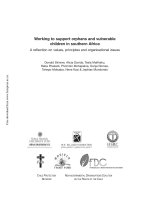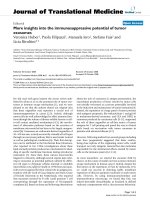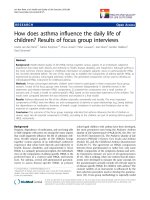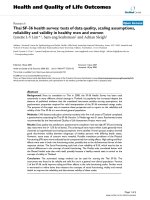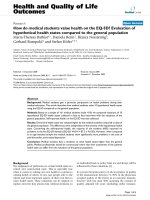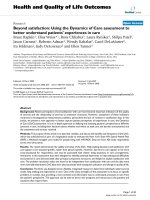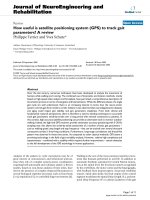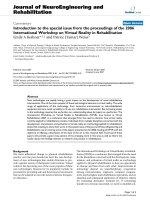báo cáo hóa học:" How to calculate the annual costs of NGO-implemented programs to support orphans and vulnerable children: A six-step approach" potx
Bạn đang xem bản rút gọn của tài liệu. Xem và tải ngay bản đầy đủ của tài liệu tại đây (269.91 KB, 53 trang )
This Provisional PDF corresponds to the article as it appeared upon acceptance. Fully formatted
PDF and full text (HTML) versions will be made available soon.
How to calculate the annual costs of NGO-implemented programs to support
orphans and vulnerable children: A six-step approach
Journal of the International AIDS Society 2011, 14:59 doi:10.1186/1758-2652-14-59
Bruce A Larson ()
Nancy Wambua ()
ISSN 1758-2652
Article type Research
Submission date 23 May 2011
Acceptance date 19 December 2011
Publication date 19 December 2011
Article URL />This peer-reviewed article was published immediately upon acceptance. It can be downloaded,
printed and distributed freely for any purposes (see copyright notice below).
Articles in Journal of the International AIDS Society are listed in PubMed and archived at PubMed
Central.
For information about publishing your research in Journal of the International AIDS Society or any
BioMed Central journal, go to
/>For information about other BioMed Central publications go to
/>Journal of the International
AIDS Society
© 2011 Larson and Wambua ; licensee BioMed Central Ltd.
This is an open access article distributed under the terms of the Creative Commons Attribution License ( />which permits unrestricted use, distribution, and reproduction in any medium, provided the original work is properly cited.
1
How to calculate the annual costs of NGO-implemented
programmes to support orphans and vulnerable children: a
six-step approach
Bruce A Larson
1,2§
, Nancy Wambua
3
1
Department of International Health, Boston University School of Public Health, Boston,
Massachusetts, USA
2
Center for Global Health and Development, Boston University, Boston, Massachusetts, USA
3
Finance Department, Benevolent Institute for Development Initiatives, Machakos, Kenya
§
Corresponding author: Bruce A Larson, Boston University School of Public Health, 801
Massachusetts Ave, 3rd fl, Boston, Massachusetts 02118 USA. Tel: +1-617-414-1260. Fax:
+1-617-414-1261
Email addresses:
§
BAL:
NW:
2
Abstract
Background
Information on the costs of implementing programmes designed to provide support of
orphans and vulnerable children (OVC) in sub-Saharan Africa and elsewhere is increasingly
being requested by donors for programme evaluation purposes. To date, little information
exists to document the costs and structure of costs of OVC programmes as actually
implemented “on the ground” by local non-governmental organizations (NGOs). This
analysis provides a practical, six-step approach that NGOs can incorporate into routine
operations to evaluate their costs of implementing their OVC programmes annually. This
approach is applied to the Community-Based Care for Orphans and Vulnerable Children
(CBCO) Program implemented by BIDII (a Kenyan NGO) in Eastern Province of Kenya.
Methods and results
The costing methodology involves the following six steps: accessing and organizing the
NGO’s annual financial report into logical sub-categories; reorganizing the sub-categories
into input cost categories to create a financial cost profile; estimating the annual equivalent
payment for programme equipment; documenting donations to the NGO for programme
implementation; including a portion of NGO organizational costs not attributed to specific
programmes; and including the results of Steps 3-5 into an expanded cost profile. Detailed
results are provided for the CBCO programme.
Conclusions
This paper shows through a concrete example how NGOs implementing OVC programmes
(and other public health programmes) can organize themselves for data collection and
3
documentation prospectively during the implementation of their OVC programmes so that
costing analyses become routine practice to inform programme implementation rather than a
painful and flawed retrospective activity. Such information is required if the costs and
outcomes achieved by OVC programmes will ever be clearly documented and compared
across OVC programmes and other types of programmes (prevention, treatment, etc.).
4
Background
An estimated 56.1 million children in sub-Saharan Africa had lost one or both parents as of
2009 [1]. Among this total, 14.9 million children lost one or both parents due to AIDS, and
large numbers of other children are vulnerable to becoming orphans because one or both
parents are HIV infected.
In response to the diverse problems and needs of orphans and vulnerable children (OVC) in
low-income countries, a range of programmes have evolved over time to attempt to improve
their daily lives and future prospects. The US government, through the US President’s
Emergency Plan for AIDS Relief (PEPFAR), spent $312 million on OVC activities in 2008
[2]. Between 2006 and 2008, more than $1 billion was spent on OVC programmes, the
majority of which targeted OVC being cared for in the community (extended family
members, other households) [3]. As part of The Reauthorization Act of 2008, significant
sums will continue to be allocated to OVC programmes between 2009 and 2013 [4].
PEPFAR-supported OVC programmes typically involve a set of organizations working
together to implement an overall OVC programme. As one example, Christian Aid was the
prime recipient for the Community Based Care for Orphans and Vulnerable Children
(CBCO) Program implemented during 2005-2010 in Nigeria, Uganda, Kenya and Zambia.
Christian Aid then collabourated with a small number of lead non-governmental
organizations (NGOs) in each country to implement the overall programmes. In Kenya, the
Benevolent Institute for Development Initiatives (BIDII), based in Machakos, Eastern
Province, implemented the programme in Eastern Province; the Inter-Diocesan Christian
5
Community Services (IDCCS), based in Kisumu, implemented the programme in Nyanza
Province. In the CBCO programme, as is typically the case with OVC programmes funded
through PEPFAR, local NGOs operating at a sub-national level deliver programme services
to OVC and their households.
Local NGOs, such as BIDII, typically implement “their” OVC programme using funds from
multiple sources including donor funds, the NGOs’ own resources, volunteers and donations
from local communities and perhaps from such sources as other programmes and the
government. Thus, the resources used to implement an NGO’s OVC programme (the costs of
implementation) are not simply the amounts budgeted within PEPFAR-funded programmes.
A review of the literature on the costs, outcomes and cost effectiveness of OVC programmes
concluded that little information exists to document the costs and structure of costs of OVC
programmes as actually implemented “on the ground” by NGOs [5]. This information is
required if evaluations of OVC programmes in terms of costs and outcomes (cost-outcomes
analysis, cost-effectiveness analysis) are to be completed and if high-performing types of
programmes are to be replicated and expanded elsewhere.
The demand for more and better information on the costs of interventions is directly included
in the United States Agency for International Development’s (USAID’s) Evaluation Policy
statement. Increased demand for costing information is also embedded into the growing
demand for implementation science, including cost-effectiveness analysis in relation to
HIV/AIDS programming[6]. Because of the multi-dimensionality of OVC programmes, as
we have discussed, we prefer to use the term, “cost-outcomes analysis”, instead of “cost-
effectiveness analysis” [5, 7].
6
The concepts and methods for evaluating the costs of programmes and projects, whether
investments in irrigation infrastructure, HIV prevention programmes, antiretroviral treatment
programmes or OVC programmes, are well documented elsewhere in textbooks and donor-
related documents [7-11]. The World Bank’s “OVC Toolkit for sub-Saharan Africa” website
also includes very reasonable guidance on costing of OVC programmes, which itself is
essentially a replication of standard training materials on costing of projects within the
broader field of benefit-cost analysis [12]. A small number of studies have applied these
methods to evaluate the costs of OVC programmes [13-17].
However, such methods are not widely integrated into routine practices of OVC programmes,
in part because existing toolkits are rather vague on how to obtain the information needed to
apply the methods. While textbooks and toolkits are important, it is difficult to convey in
such materials the experience, creativity and decisions needed to implement the methods.
The goal of this paper is to show through a concrete example how NGOs implementing OVC
programmes (and other public health programmes) can organize themselves for data
collection and documentation prospectively during the implementation of their OVC
programmes. The significance here is that costing analyses can become routine practice to
inform programme implementation, rather than a painful and flawed retrospective activity.
Rather than attempting to train programme implementation staff on these procedures,
financial/accounting staff (perhaps one person) can logically perform costing analyses as a
relatively minor addition to their existing activities. Such information is required if the costs
and outcomes achieved by OVC programmes will ever be clearly documented and compared
across OVC programmes and other types of programmes (prevention, treatment, etc.).
7
To achieve this goal, this paper provides a logical six-step approach that researchers and local
NGOs themselves can use to document and describe the annual costs of implementing their
programmes. The paper is organized as follows. The six-step approach is explained in the
Methods section. The Results section then provides a detailed example using the CBCO
programme implemented by BIDII in Eastern Province of Kenya. A few additional final
issues are then addressed in the Discussion section. The paper concludes with a set of
practical recommendations for integrating this six-step method into routine practice during
programme implementation.
Methods
Table 1 provides a brief summary of the six steps for evaluating the costs of implementing
OVC support programmes. A prerequisite for costing of any intervention is a clear definition
of the intervention. OVC programmes implemented by NGOs typically provide multiple sets
of inputs to OVC and/or their households, such as food and nutrition support, access to health
services, psychosocial support, educational support, and support for household economic
strengthening. Through these activities, the programmes work to improve the welfare of OVC
and their households along several dimensions (improved food security, educational and
psychosocial outcomes, household access to credit, improved income and household wealth,
etc.) [5].
In general economic terms, OVC programmes operate like multiple input and multiple output
firms, just like household-based farming operations that combine multiple inputs (labour,
8
fertilizers, seeds) to produce multiple types of crops (cassava, maize, plantains) on the same
piece of land. To begin any costing analysis of an OVC programme, a clear description of the
complete OVC programme is required, not just one portion of the programme. This issue will
be discussed further during the example provided in the Results section.
Step 1. Access and organize financial reports
The first step is to access and review the NGO’s annual financial report that documents
itemized expenditures for the programme during a year. Itemized expenditures, sometimes
called expenses, are payments actually made by the NGO. Such expense reports are routinely
produced by organizations for accounting, tax reporting and donor reporting purposes. NGOs
will typically have an overall annual financial report that encompasses all its activities. This
overall NGO financial report will typically include (or be based on) a number of sub-reports
for each external funding source. It is necessary to access the “programme-specific” annual
financial report. Such reports are typically developed by the NGO’s accounting or financial
staff using a spreadsheet programme, such as Microsoft Excel.
In some situations, an NGO might implement its OVC programme with funding from
multiple sources (e.g., USAID, the UK’s Department for International Development,
donations from a US faith-based organization, local government funds, and/or donations from
a local church congregation). Regardless of where the funds come from, the NGO will have
an annual financial report, which may include a sub-report for each donor. When a
programme is implemented with funding from multiple donors, each with perhaps a different
fiscal year for reporting expenses, a costing analysis based on a calendar year regardless of
funding source would be a logical approach. Alternatively, the fiscal year that coincides with
the NGO’s fiscal year or the largest donor’s fiscal year could be used.
9
A prerequisite to complete Step 1 and to proceed with any costing analysis of NGO
programmes is the willingness of the NGO and its staff, especially the financial and/or
accounting staff and the programme manager, to support the activity. This is easiest when the
NGO itself is undertaking the analysis and the funders and NGO management agree that such
information is needed for on-going project management and evaluation purposes.
Step 2. Link financial report sub-categories to input cost categories
The purpose of Step 2 is to reorganize the information contained in the financial report into
logical groups of expenses for key categories of “inputs” used in the implementation of the
project. Just like seeds, pesticides, fertilizer, land, household and hired labour are key inputs
in agricultural production, NGO-implemented OVC programmes have some underlying
“production technology” that transforms inputs into outputs. Typical input categories include
office and buildings, vehicles, programme staff, office equipment, office supplies, supplies
and items provided directly to OVC and their households. As will be shown in the Results
section, Step 2 can be accomplished relatively easily through minor adjustments to financial
reports (the Excel file used for expense reporting). Thus, no new software or models are
needed to complete the analysis.
Knowledge of the programme and the information developed as part of Step 1 will provide
the information needed to identify logical input categories for an OVC programme. In our
experience, the NGO programme inputs can typically be organized into a relatively small
number of key input categories that describe how the project was actually implemented, such
as payments for education, NGO staff salaries, transportation, small stipends to volunteers,
and agricultural inputs. In most cases, while input categories could be further disaggregated
10
into addition sub-categories (fuel, vehicle servicing, insurance), the additional level of detail
is typically not required.
If the NGO also sub-contracts to another organization to assist with implementing the
programme, then the NGO’s financial report will typically include payments to the sub-
contract recipient (for example, quarterly transfers of funds). In such situations, the costing
analysis would be completed twice (one for the prime organization and one for the sub-
contract recipient) for a complete costing analysis.
Step 3. Estimate the annual equivalent payment for programme equipment
NGOs will typically have an inventory of equipment purchased specifically for the
programme. Some of these items are purchased directly by the NGO (and included as an
expense in the programme-specific financial report), but some could be purchased by another
organization or the funding agency and provided to the NGO (and therefore not included in
the NGO’s financial report). Regardless of who purchased the equipment, the NGO should
have an inventory list of equipment in its possession (typically for insurance purposes,
avoiding theft, and so on). As a simple rule of thumb, equipment (also called durable goods,
assets, and so on) can be viewed as items that are intended to be used by the NGO to
implement its programme across more than one year.
Two general situations exist regarding equipment: (1) the equipment was purchased directly
during the programme period; and (2) the NGO already had the equipment before the
programme began. A vehicle is a typical example of equipment. Sometimes, vehicles are
purchased directly by the project, often towards the beginning of a funding cycle from a
donor, for example. Sometimes, an NGO has already purchased or received donated vehicles,
11
but uses them for programme implementation. A building used as an office is another
example, where, typically, an NGO may have acquired the building in the past, sometimes
many years in the past. A new battery purchased for a laptop computer could also be
considered “equipment” because the battery life is intended to be more than one year.
Rather than attempting to justify here an appropriate definition of equipment, two simple
criteria can be used to define equipment: (1) the item is intended to be used by the
programme over more than one year; and (2) the actual retail price to replace the item is
below an “equipment threshold”. In many countries, tax policies will provide guidance on
what equipment is. Many donors that fund OVC programmes also have their own definitions.
For example, individual items purchased for more than $500 is a typical threshold for
USAID-funded programmes.
When equipment is rented or leased, the annual rental or lease amount would already be
included in the financial report, in which case nothing else is required. These actual payments
reflect the annual cost of the equipment to the NGO. Other expenses associated with the
equipment, such as maintenance, would also already be included in the financial report.
When equipment is purchased rather than rented, however, the expense is included in the
financial report just in the purchase year, but the equipment (e.g., vehicle) is used across
multiple years. As a result, expenses are “higher” when the vehicle is purchased, and
expenses are “lower” in the years after it is purchased but is being used by the programme.
When evaluating the annual costs of implementing a programme, annualizing equipment
purchases, by translating a lump sum payment in one year into a certain number of equal
12
annual payments over multiple years, is an easy way to account for equipment used for
programme implementation. Estimating an annual cost equivalent for equipment is also very
easy to do with typical spreadsheet programmes that are already used by NGOs for creating
their financial reports. Again, no new software is likely to be needed.
NGOs can use any standard “annual payment calculator” to calculate the annual equivalent
payment to cover a one-time purchase over a certain time period (e.g., from the purchase year
to the end of the project) given a specific discount/interest rate. A “scrap value” can be
included if the item continues to have value at the end of the project (e.g., the NGO can sell a
used vehicle). For example, the “pmt” function in Excel is easy to use and calculates an
annual constant payment that would be required to cover the equipment purchase over a
specific time period with a specific interest rate (used to discount future values). For example,
if a project purchased a piece of equipment for $10,000 in 2006, and if a five-year working
life is assumed, and a 10% annual discount rate is used, the function = pmt(10%, 5, 10,000, 0,
0) yields $2637.97. This is the annualized payment equivalent for the vehicle purchase. If the
programme expects to be able to resell the vehicle at the end of the project, for example, for
$2500, then the function = pmt(10%, 5, 10,000, -2500, 0) yields $2238.48.
With a 0% discount rate and no resale of the vehicle, the same pmt function yields $2000
(simply the price divided by the number of years). The difference of $637.97 between a 10%
and 0% discount rate represents the opportunity cost of funds used to purchase the equipment
with a 10% discount rate. While the discount rate should reflect the NGO’s opportunity cost
of capital (or perhaps social cost of capital), the theory and practice of choosing the right
discount rate is less than precise and not addressed here.[9] However, the US government
typically tells agencies what discount rate to use when analyzing investment projects (but not
13
all types of projects are required to use the same discount rate). Our view is that financial
capital for longer-term investments is obviously scarce for most organizations in sub-Saharan
Africa, private companies and NGOs alike. As a result, a positive real discount rate is clearly
appropriate to use for programme costing activities. For this analysis, we have chosen to use
a 10% discount rate throughout. NGOs and their funding agencies should discuss appropriate
discount rates for this type of analysis.
In the example we have used, the purchase occurred in 2006. If the costing analysis was
conducted for 2009, the annual payment of $2637.97 based on the 2006 purchase year would
have to be inflated to 2009 levels to be included in an analysis for 2009. The annual average
consumer price index is logical to use. Such information is typically available from the
country’s central bank. The International Monetary Fund’s World Economic Outlook
Database (
provides
easy access to inflation figures for most countries.
Step 4. Document donations to the NGO for programme implementation
NGOs often receive donated goods and services from other organizations and individuals that
are then used for programme implementation (e.g., bednets received from a health project and
then distributed to OVC by the NGO). Donations include items provided free of charge to the
NGO, as well as items provided at a subsidized price. For example, a nurse might volunteer a
day of her time (maybe during annual leave) to work with the OVC programme. If she
receives no payment or token of appreciation, her services are free to the project. If she
receives something, such as lunch or transportation costs or some small token of appreciation,
her services are not free, but very much below what it would cost the project to the hire a
nurse for a day. If the donation involves equipment (such as a computer), the market value of
14
the computer would be used as the price used for annualizing equipment purchases addressed
in Step 3.
The quantity of donated items should be recorded by the NGO as feasible (for example, as an
extra worksheet within its financial report spreadsheet). A market value for many items is
typically easy to find so that the costs of such items can be identified. Healthcare products,
seeds, fertilizers, clothing, shoes, school supplies and so on are often the types of items that
might be donated to NGO programmes (which in turn provide to their programme
participants). At a minimum, the quantity of donated items can be recorded so that the market
value can be investigated at a later date.
NGO OVC programmes, especially faith-based programmes, typically rely on volunteers for
programme implementation. Volunteers receive no salary from the NGO, but sometimes
receive some financial payments (small stipends or tokens of appreciation). Information on
the number of volunteers involved, the amount of time each contributes to the programme
and the services provided as part of programme implementation are usually not well
documented. How to obtain better information on volunteers used for programme
implementation in a reasonable fashion is beyond the scope of this paper. Until personnel-
type records are maintained by NGOs for volunteers contributing to their programmes,
however, such information will continue to be based on estimates of varying quality.
By better documentation of the numbers and types of volunteers (for example, local women
providing counselling support to other OVC caregivers, extension agents providing advice on
agricultural production, medical doctors providing health exams), one goal here is simply to
appreciate the importance of such volunteers when considering the expansion or replication
15
of the programme elsewhere. A second goal is to provide a level playing field when
considering the costs and outcomes achieved for various OVC programmes. A programme
implemented with volunteers might look very inexpensive, but such information would be
misleading when considering a replication of the programme elsewhere in the absence of
large numbers of volunteers with similar credentials.
Step 5. Include a portion of NGO organizational costs not attributed to specific
programmes
NGOs typically implement multiple programmes. Their OVC programme might be funded
through a sub-contract with a US-based organization that has a contract from USAID. A
health and sanitation programme might be funded through a UK-based organization with
funding from the UK’s Department for International Development. An education programme
might be funded through a Japanese NGO with funding from Japan International Cooperation
Agency
Each individual programme will likely have a programme-specific financial report. The NGO
will also have an annual overall financial report that combines these programmes-specific
financial reports and includes additional expenses not attributed to specific projects. For
example, a general director or high-level manager might not be accounted for in a specific
programme budget. For this step, it is reasonable to allocate a share of the NGO’s
organizational costs (costs not included elsewhere in specific programmes) to the programme
based on the share of the programme’s financial costs as a share of all externally funded
costs.
Step 6. Include the results of Steps 3-5 into an expanded cost profile
16
The final step in this NGO programme costing approach is simply to organize the results
from Steps 1-5 into an expanded cost profile that includes the results from Steps 3-5.
Results
Introduction to the Community-Based Care for Orphans Program
The CBCO programme provided services to households caring for OVC [18]. These
households were often members of the extended family, which is the typical case for OVC in
developing countries. As is well recognized, a substantial share of households in developing
countries is not able to meet the material and emotional needs of OVC because they are poor.
They were poor before assuming responsibility for their charge, and they perhaps became
even poorer with the additional person in the household. If the economic situation of these
households was adequate, the basic material needs of OVC – food, shelter, clothing,
education, healthcare, protection – would be provided by these households and there would
be substantially less needs for OVC support programmes.
The core activity within the CBCO programme was the support of village “saving and loan
associations” (SLAs). An SLA is comprised of representatives from OVC households
(usually a guardian), who form a group (the SLA) and meet regularly (e.g., once a week,
twice a month). SLA members make a standard contribution (e.g., 25 Kenyan shillings) at
each meeting (savings contributed at SLA meetings are kept in the SLA’s lock box). The
SLA model, which is a variation on a community-managed micro-finance institution, was
developed in the 1990s and been widely adopted around the world [19].
17
As of 2009, there were 108 SLA groups in the CBCO programme in Kenya (52 with BIDII in
Eastern Province and 56 with IDCCS in Nyanza Province), with participation of more than
2500 households. SLA members are typically female, often household heads, who are the
primary guardian or “caregiver” for OVC as well as potentially her own children in the
household. These households included 7201 OVC in both provinces.
The CBCO programme supported the organization and operation of SLAs in the programme
through SLA facilitators. These facilitators attended the regular SLA meetings, provided
training on financial management and record keeping (and assisted SLAs as they became
familiar with these activities), and provided additional information to the group for income-
generating activities. The facilitators were also the conduit through which the CBCO
provided supplies to the SLAs (e.g., inputs for income-generating activities) and other
services, including additional information and training to SLA members related to business,
agriculture and OVC welfare. In many respects, the SLA facilitators acted like agricultural
and household extension agents for SLA groups. At times, SLA facilitators would arrange for
staff from local government agencies to attend SLA meetings for information exchange.
Each SLA identified two members who served as “mentors” for the CBCO programme.
These mentors were responsible for periodically visiting children living in SLA member
households. These mentors essentially served as informal social workers in their
communities.
The CBCO programme also provided other goods and services directly to households (and
sometimes through the SLA). These services included food and nutrition support (provision
of seeds, livestock, training on growing kitchen gardens, direct food donations), medical
18
support for OVC in the household, support for school fees for OVC, caregiver training related
to child protection and psychosocial support and child protection, and services related to
income-generating activities (e.g., information, training). The CBCO programme also
provided school-based programmes (youth and kids clubs) through “peer educators” leading
after-school programmes (focused on educational support, health and life skills training, and
other psychosocial support). SLA members and OVC in the programme did not receive the
same “package of services” within or across years.
Results for Step 1 (access and organize financial reports)
For this analysis, the evaluation year is specifically 1 October 2008 until 30 September 2009,
which is the US government fiscal year (FY2009) used for reporting purposes.
BIDII’s financial report is contained in an Excel spreadsheet with one worksheet for each
quarter. These worksheets were then combined into one worksheet for analysis. The
worksheet is organized into six major expense report categories, which are listed at the top of
Figure 1. Each expense category is coded as 1-7 (no number 6). Each line in the
worksheet/dataset is an itemized expense that includes a short description of the expense, the
date paid, and an expense number (typically a number written on the original receipt
documenting and the payment).
In Figure 1, the number of individual itemized expenses in each financial report category is
provided. For example, n=88 under the personnel category indicates 88 itemized expenses.
Total financial expenses for the CBCO programme were 5,448,439 Kenyan shillings (KES)
in 2009 ($US75,673 using an average annual exchange rate of KES72 to the US dollar).
19
After reviewing individual expenses in the financial report database, more detailed sub-
categories within each category must be created to facilitate reorganizing information in the
financial report into input categories. After reviewing a financial report, consistent groups of
itemized expenses are typically easy to identify. For example, in the financial report
categories 1 and 2 (personnel and fringe benefits), the 88+9 = 97 itemized expenses fell into
five basic sub-categories. At this stage, one extra field (a column in Excel) is added to the
financial report and a four-digit financial report sub-category code was created (e.g., 1100 for
salary payments, 1300 for health and social insurance payments). The full set of financial
category sub-codes with descriptions is provided in Figure 1. Each individual itemized
expense in the annual financial report (321 individual line items) is then assigned a sub-
category code.
Four typical issues are noted here. First, payments to individuals involved with actual
implementation of the project are not always included in the personnel categories. For
example, BIDII staff members are included in the financial report categories 1 and 2 as
“personnel”, while payments to facilitators are included in financial report category 5 (OVC
services).
Second, one expense item in the financial report could be one total salary payment for NGO
staff for that month (not a specific amount of each individual staff member) or one general
payment for social taxes. In general, a detailed breakdown by individuals is not needed or
recommended (a costing analysis is not an audit) and would raise multiple issues around
confidentiality.
20
Third, the project purchased no equipment in the year. Issues associated with equipment are
discussed in Step 3. And fourth, individual line-item expenses (typically based on an
underlying receipt documenting the payment) may combine multiple purchases. For example,
financial report sub-category 5901 includes expenses incurred for three reasons (SLA
materials, materials for mentors, and materials for kids’ clubs organized at local schools) that
would be useful to have disaggregated to each specific purpose. When such combined
expenses are a relatively small share of total expenses, it is typically not worth the effort to
attempt to locate the hard copy of the payment receipt to attempt to breakout into individual
items.
Results for Step 2 (link financial report sub-categories to input cost categories)
Based on the sub-categories in the financial report in Figure 1, Table 2 shows how the
expense report sub-categories were allocated to eight major input categories that describe the
production structure of the CBCO programme. An extra field (column in Excel), called “cost
category code”, was added to the financial report. Each itemized expense in the financial
report was also given one of the cost category codes.
Based on the input categories in Table 2, Table 3 provides a summary of the financial cost
structure of the BIDII CBCO programme for FY2009 by input category. Table 3 is the
financial “cost profile” for the project. To create Table 3, the financial report was simply
sorted by cost category code and then the expenses summed up for each category. Such
sorting and summarizing can be done in the financial report electronic file using the same
software (e.g., Excel or any other spreadsheet programme). No new software is needed and
no separate costing model is needed.
21
Depending on the size of the project, it sometimes will be useful to disaggregate further the
major input categories into more detail as needed. Table 2 provides the logical grouping of
sub-categories of inputs that were created in Step 1, which would be used for further
disaggregation.
The largest input cost categories in terms of direct financial expenses for the BIDII CBCO
programme were direct educational expenses for OVC (30%), BIDII personnel (20%), NGO
travel/meetings/monitoring and evaluation costs (17%), and materials for SLAs (15%).
Office-based expenses (e.g., office rent and supplies in categories 2 and 3) were a small share
of total expenses (<6%). Table 3 also shows that payments for SLA facilitators and mentors,
two key inputs into the production structure of the CBCO programme, accounted for
relatively minor shares of total financial expenses (<9%). Also note that no equipment was
purchased during FY2009. We will return to a discussion of cost structure (e.g., is 20% for
personnel high, low, typical?) after completing the remaining steps in this costing analysis.
Results for Step 3 (estimate the annual equivalent payment for programme
equipment)
The CBCO programme purchased seven items considered to be equipment during the project,
which are listed in Table 4. A service life of five years was assumed, based on the expected
programme implementation period. Kenyan inflation (annual average based on consumer
price inflation) figures were taken from the International Monetary Fund’s World Economic
Outlook Database.
The Toyota Land Cruiser was by far the largest equipment purchase, with a price of KES2
million in 2007. This price is actually lower than a typical local price (e.g., in Nairobi)
22
because Christian Aid was able to procure and import the vehicle tax and duty free due to its
USAID funding (and US government agreements with the Kenyan government). As a result,
this item did not show up directly in BIDII’s financial report. If Christian Aid did not receive
this subsidy, the purchase price would have been at least 30% to 50% higher. We assume that
the vehicle could be resold for 30% of its value after five years. With a 10% discount rate for
equipment purchases, the annualized value of all equipment inflated to 2009 values based on
Kenyan consumer price inflation is KES604,856. For reference, inflation information for
Kenya is also provided in Table 4.
Results for Step 4 (document donations to the NGO for programme implementation)
Volunteers were a central component of the CBCO programme. BIDII has good information
on the number of individuals contributing time for implementing the programme (and
different categories of individuals and their activities), but not detailed records on the
quantity of time contributed by each individual weekly or monthly or yearly.
As a result, information on the general amount of time that different types of volunteers
contributed to the BIDII OVC programme was developed through informal interviews and
discussions with programme staff and volunteers. The goal was to understand average
amounts of time that various categories of volunteers contributed weekly or monthly. No
individually specific information was created in this case. The typical complication here is
that some NGO staff might consider themselves to be under paid (and therefore volunteering
time to the project), while others considered to be “volunteers” might receive some payments
as well (sometimes called motivation, sometimes recognition, and so on).
23
To consider how to identify volunteers contributing to the programme, all categories of
people who contributed time to implementing the programme (paid and unpaid) were
identified first. All individuals included as “personnel” in the NGO’s financial report (see
Table 1 and Figure 1) were considered as employees and therefore not as volunteers.
Besides the NGO staff who implemented the programme (with salary and related payments
included in the financial report as personnel and benefits in Figure 1), the CBCO programme
relied directly on four groups of individuals for programme implementation:
1. The SLA facilitators provided several types of direct support to SLAs. For example, they
assisted with record keeping of the SLA and they delivered programme supplies to the SLA
(e.g., the box for savings, locks for the box, materials used for group income-generating
activities). Facilitators provide information on income-generating activities that the SLA or
individual members might pursue, which might also include organizing for an outside
speaker to attend SLA meetings.
2. Peer educators had a similar status as the SLA facilitators within the CBCO programme,
but they led the school-based programmes for OVC.
3. SLA mentors were recruited from SLA members to serve essentially as social workers
within the project. They conducted direct visits to homes of SLA members for counselling,
support and evaluation of OVC caregivers (typically the SLA member) and their children.
4. The programme relied on a CBCO committee in each programme “impact zone”. An
impact zone is a sub-location in Kenya (government location), and the several SLAs in each
sub-location are associated with each CBCO committee.
24
Table 5 provides estimates of the annual amount of time contributed to the CBCO
programme annually. The CBCO operated in six “impact zones”. A coordinating committee
comprised of 20 members provided oversight support in each zone through a monthly
meeting. In addition to general oversight, committee members followed up with individual
OVC cases where serious problems were identified. Based on discussions with BIDII, we
estimate that each committee member allocated about one day (eight hours) per month to the
coordinating committee. With 20 members per zone and six zones, this adds up to about 120
days per month for these committee members.
The CBCO programme provided two SLA facilitators and two peer educators for each impact
zone (six impact zones), with eight or nine SLAs per impact zone. Based on discussions with
programme staff, facilitators and peer educators, facilitators worked about 15 days per month
on SLA activities, and peer educators worked about 12 days per month (school-based kids’
and youth club activities). Based on these estimates, all facilitators combined contributed 180
days per month of time to the project (2*6*15) while all peer educators combined contributed
144 days per month (2*6*12).
And finally, 102 SLA members contributed to the CBCO programme as mentors. With
roughly 30 SLA members in each SLA, each mentor would work with approximately 15
households. Based on discussions with mentors and CBCO programme staff, mentors were
estimated to allocate half a day per month to each SLA household. This time includes round
trip travel time to the SLA member’s home, time for interaction with the SLA member, and
time for interaction with children in the SLA household. With 0.5 days per household and 15
households per mentor, this adds up to 7.5 days per month or a total of 780 days per month of
mentor time contributed to the CBCO programme.

